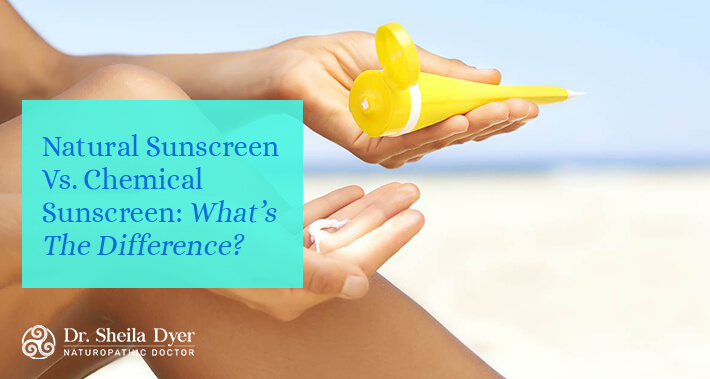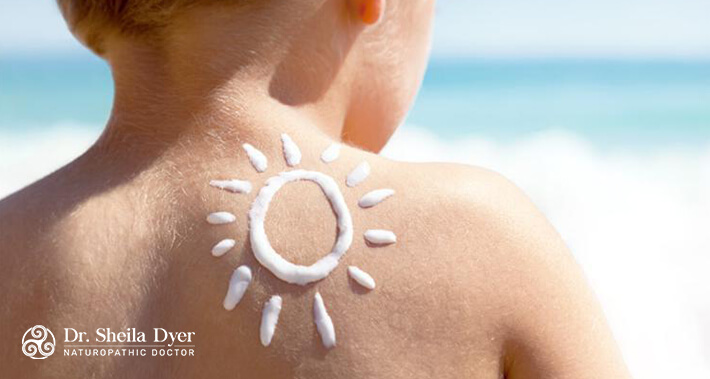
It’s summertime and you want to spend as much time outside as possible.
Being Canadians, we only get a few really nice months every year, and we don’t want to let them go to waste.
You know all of the tips to stay safe.
Drink lots of water.
Avoid peak times when the sun is at its hottest.
Wear sunscreen.
But trying to decide on what type of sunscreen to buy can be confusing.
Standing in the sun-care aisle, trying to decipher the packages of natural skin health solutions versus chemical sunscreens can be a daunting task.
I’m Dr. Sheila Dyer, N.D., a Toronto naturopath and I’m going to help you decipher the different types of sunscreen so you can decide which one is right for you.
What Is Natural Sunscreen?
Natural sunscreen is also sometimes called mineral sunscreen or physical sunscreen.
It works by sitting on top of your skin and literally works as a physical barrier to block the sun from getting to your skin.
All types of natural or mineral sunscreen will contain either one or both of zinc oxide and titanium dioxide.
What Is Chemical Sunscreen?
Chemical sunscreens work by first being absorbed by the skin, and then the chemicals in the sunscreen absorb the UV rays from the sun so that they don’t cause skin damage.
These tend to include ingredients such as avobenzone, oxybenzone, octinoxate, and octisalate.
Because they require time to absorb into the skin, chemical sunscreens need to be applied approximately 20 minutes before sun exposure, whereas natural or physical sunscreens have no wait-time.
What Makes A Sunscreen “Natural?”
Natural sunscreens all called themselves this because they work in a different way than chemical sunscreens.
They are quite literally providing a physical barrier between your skin and the sun, versus allowing any chemicals or UV rays to be absorbed by the skin.
Are Natural Sunscreens Healthier?
For many people, the idea of having chemicals being absorbed into the skin isn’t very appealing.
There is good reason to be wary – some of the ingredients found in chemical sunscreens are what are known as hormone disrupters.
What this means is that the can impact the glands which control estrogen levels and thyroid activity, as well as other hormones.
Natural sunscreens don’t generally have chemicals linked to hormone disruption.
Important Ingredients In Natural Sunscreens
Natural sunscreens will always contain one or both of titanium dioxide and/or zinc oxide.
Rather than being absorbed by the skin, these ingredients sit on top of the skin and act as a physical barrier between you and the sun.
These are one of the oldest types of sunscreen.
Ingredients To Watch For In Chemical Sunscreens
Some people choose chemical sunscreens because they go on smoother, and don’t leave a white, chalky residue on the skin.
If you do choose to use chemical over natural sunscreens, there are some ingredients to watch out for.
Some of these, and why they can be problematic, are listed here.
1. Parabens
Parabens are used as preservatives in cosmetic, skin, and body care products.
They prevent bacteria and mould from developing on products but also act as hormone disrupters in the body.
Issues with parabens include skin irritation, increased risk of cancer, and impacts to fertility.
2. Sulphites
Sulphites are an additive used in products such as food, drink, and pharmaceuticals to prevent food from being discoloured, extend shelf-life, and prevent bacterial growth.
Although generally considered safe to eat when in food products, they can cause reactions in people with sulphite-sensitivities.
Reactions may include headaches, asthma symptoms, and reactions similar to those of a food allergy.
3. Oxybenzone & Octinoxate
Oxybenzone is a chemical used in sunscreen which absorbs UVA and UVB rays.
The end result of this absorption is lowered penetration of radiation by the skin, leading to a reduced risk of damage.
It has been found to be a hormone disrupter, is linked to altered birth weights, and low testosterone levels in teenage boys, as well as has high rates of causing skin reactions.
Attempts are being made to ban both oxybenzone and octinoxate in Hawaii due to their damaging effects on coral reefs.
4. Homosalate
Another hormone disrupter found in chemical sunscreens, homosalate affects estrogen, androgen, and progesterone levels.
It is absorbed by body and has been found in breast milk.
Due to concerns around homosalate, it has been banned from use in Japan.
5. Octisalate
Octisalate is an ingredient used in chemical sunscreens which has been linked to allergic reactions and harm to the immune system.
Due to concerns over its safety, use of octisalate is restricted in Japan, however more studies need to be done to determine its effects.
6. Octocrylene
Octocrylene not only accumulates in the body, but has also been
found in fish living near wastewater treatment plants.
It has also been found in breast milk, and has high rates of causing skin irritation and allergies.
Book An Appointment With Dr. Sheila Dyer, ND
Are you worried about exposure to chemicals in sunscreens and other products you use regularly?
Or perhaps you are experiencing symptoms such as low energy, anxiety, depression, or having unexplained mood swings which could be due to hormone disruptions.
I’m Dr. Sheila Dyer, ND, a Toronto-based naturopathic doctor, and I can help.
I offer natural solutions to help you manage your hormone levels, to get you feeling healthy again.
Contact me today to book a consultation.
If you have questions about naturopathic medicine, or would like to start with your first consultation, contact me, and let’s book an appointment.
Dr. Sheila Dyer, ND1080 Dovercourt Rd,
Toronto, ON M6H 2X8
(416) 554-5135
► https://g.page/DrSheilaDyerNd
Dr. Sheila Dyer is a Naturopathic Doctor and a practicing registered nurse offering holistic healthcare with a scientific focus
